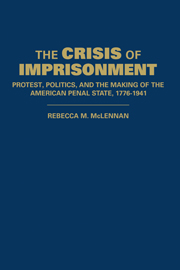Book contents
- Frontmatter
- Contents
- Acknowledgments
- Introduction: The Grounds of Legal Punishment
- 1 Strains of Servitude: Legal Punishment in the Early Republic
- 2 Due Convictions: Contractual Penal Servitude and Its Discontents, 1818–1865
- 3 Commerce upon the Throne: The Business of Imprisonment in Gilded Age America
- 4 Disciplining the State, Civilizing the Market: The Campaign to Abolish Contract Prison Labor
- 5 A Model Servitude: Prison Reform in the Early Progressive Era
- 6 Uses of the State: The Dialectics of Penal Reform in Early Progressive New York
- 7 American Bastille: Sing Sing and the Political Crisis of Imprisonment
- 8 Changing the Subject: The Metamorphosis of Prison Reform in the High Progressive Era
- 9 Laboratory of Social Justice: The New Penologists at Sing Sing, 1915–1917
- 10 Punishment without Labor: Toward the Modern Penal State
- Conclusion: On the Crises of Imprisonment
- Select Bibliography
- Index
7 - American Bastille: Sing Sing and the Political Crisis of Imprisonment
Published online by Cambridge University Press: 18 August 2009
- Frontmatter
- Contents
- Acknowledgments
- Introduction: The Grounds of Legal Punishment
- 1 Strains of Servitude: Legal Punishment in the Early Republic
- 2 Due Convictions: Contractual Penal Servitude and Its Discontents, 1818–1865
- 3 Commerce upon the Throne: The Business of Imprisonment in Gilded Age America
- 4 Disciplining the State, Civilizing the Market: The Campaign to Abolish Contract Prison Labor
- 5 A Model Servitude: Prison Reform in the Early Progressive Era
- 6 Uses of the State: The Dialectics of Penal Reform in Early Progressive New York
- 7 American Bastille: Sing Sing and the Political Crisis of Imprisonment
- 8 Changing the Subject: The Metamorphosis of Prison Reform in the High Progressive Era
- 9 Laboratory of Social Justice: The New Penologists at Sing Sing, 1915–1917
- 10 Punishment without Labor: Toward the Modern Penal State
- Conclusion: On the Crises of Imprisonment
- Select Bibliography
- Index
Summary
Come up her (sic) and write us up. … They are starving us. Give it a good write up in your paper.
Unidentified Sing Sing prisoner, to reporters, 1913In the early 1910s, the mounting internal crises of New York's prisons fused with the escalating struggle over the structure and purpose of government to produce a highly combustible alloy. That alloy exploded at Sing Sing in the summer of 1913. When Sing Sing's convicts threw their inedible rations through the windows of their cellblock, they catapulted the internal crisis of imprisonment over the walls of the institution and into the public sphere. Conscious of the presence of the press just beyond the prison walls, the defenestration of the “bastille” amounted to a disciplined, if spontaneous, protest against the conditions of imprisonment. Making emissaries of the reporters, prisoners effectively broadcasted an ultimatum to the prison bureaucrats, state legislators, New York's Governor, William Sulzer, and the free citizens of New York: Prisoners would not cooperate with a regime that had been progressively malnourishing, overcrowding, and sickening them. The act of breaking hundreds of windows with missiles of bread so stale it could shatter thick glass rudely punctuated the prisoners' point: The state would have to provide its convicts with edible food and ameliorate living conditions at Sing Sing or face collective, and quite possibly spectacular, acts of defiance.
- Type
- Chapter
- Information
- The Crisis of ImprisonmentProtest, Politics, and the Making of the American Penal State, 1776–1941, pp. 280 - 318Publisher: Cambridge University PressPrint publication year: 2008



